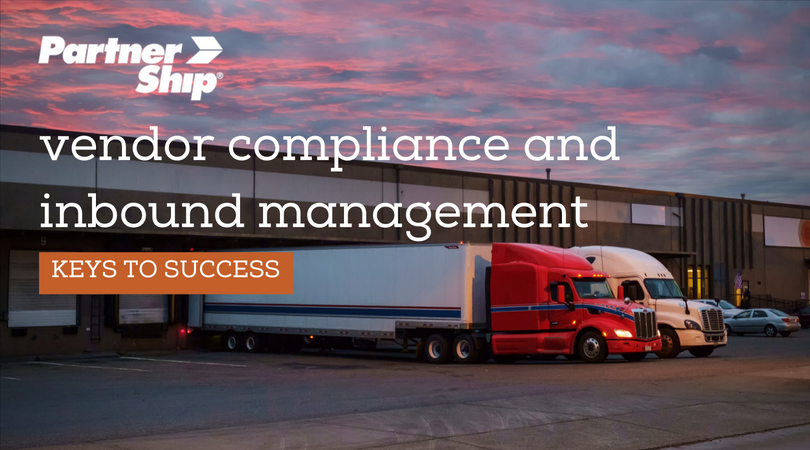Keys to Success for Vendor Compliance and Inbound Shipping
10/24/2025 — Leah Palnik

For many retailers, obtaining vendor compliance and maintaining smooth inbound shipping operations may seem like a tall order. However, with the right planning and follow through, it is achievable. By following these keys to success, you’ll be on your way to reducing your freight costs, avoiding chargeback issues, and creating efficient operations.
Developing an effective routing guide
The very foundation of achieving vendor compliance is developing an effective routing guide. Routing guides provide shipping instructions to your vendors that help you gain control of your inbound shipments. They often include modes and carriers for specific lanes, as well as rate and service requirements.
In order to create routings that are best for your business, you’ll need to consider several factors. Price, transit time, and reliability are all important when selecting a carrier and determining how to have your product shipped. For different services and weight breaks, you want to designate a carrier that provides you with the best rate and can deliver your product in the time you need.
Conducting an in-depth analysis of your inbound shipments can be time-consuming but necessary when determining your routing instructions. This is where working with the right freight broker can make a huge difference. The broker you work with should provide inbound management services that help determine the routings that will be best for your business and will create the routing guide for you – saving you valuable time.
Maintaining good relationships with your vendors
For smooth inbound shipping, you want to have a good rapport with your vendors. Like any other relationship, communication is key. For example, when you send your routing guide out to your vendors, it’s a good idea to include a request for confirmation. However, you won’t always receive one. If that’s the case, following up and opening the lines of communication will be your best bet to ensure vendor compliance.
If your vendors aren’t using your routing instructions after receiving your routing guide, you’ll need to follow up with a call or email. When you have a good relationship with your vendor, you’ll have the right point-of-contact and will be able to resolve the issue quickly. If not, you could have a harder time achieving vendor compliance.
Maintaining a relationship with your vendors can be difficult and time-consuming. This is another area where working with the right freight broker can make a difference. When selecting a freight broker, ask about experience in your industry. Quality freight brokers familiar with your industry will already have an established relationship with many of your vendors, which will help with compliance efforts.
Perfecting your order forecasting
Managing your inventory can be challenging. But the advantages of forecasting and planning your orders ahead of time are too great to ignore. When you don’t plan ahead and then need your product within a shorter time-frame, you will have to rely on costly expedited services. Spending the time up front to make sure your orders are placed with ample time will be better than spending the extra money in the long-run.
Also, with more lead time, you’ll be in a better position to handle any issues that arise. For example, if your shipment gets lost or damaged in transit and you need your product immediately, you’ll be out of luck. In that event, you’ll need to file a freight claim which doesn’t always guarantee compensation and is often a lengthy process.
If you’re not able to place your orders ahead of time, it’s a good idea to consider freight insurance. Unlike relying on carrier liability coverage, you won’t have to worry about if the carrier is found liable or not and often times you’ll get paid out much faster – making it easier to resume operations as normal.
Conducting regular reviews for improvements
Once you do have a routing guide in place and have vendor compliance, you can’t just set it and forget it. It’s best to review your routing instructions periodically so that you’re always getting the best rates and service possible.ou can choose to set aside a specific time each year to do a review. But if you make any changes throughout the year with your orders or any other factor that affects your shipments, you’ll want to take that time to evaluate and update if necessary.
It’s also important to stay on top of carrier rate increases, accessorial changes, and NMFC updates. These kinds of changes can have a significant effect on your freight costs and you'll want to make sure that you fully understand how these changes will affect your specific shipments. For example, carriers announce general rate increases every year and will present an average increase. If you simply use that average to judge how your costs will be affected, your budget will most likely be off. The increases vary greatly across the board depending on a number of characteristics, so it's important to evaluate them based on your specific shipments.
Partnering with the right freight broker
The keys to vendor compliance and inbound shipping management are easy to master when you work with the right freight partner. PartnerShip can help conduct a complete inbound shipping analysis, create a routing guide, and send routings on your behalf for vendor compliance. Contact us today to learn more about managing your inbound shipments!